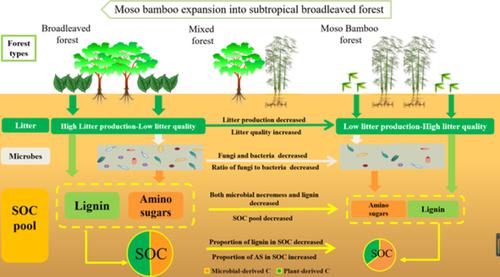当前位置:
X-MOL 学术
›
Eur. J. Soil Sci.
›
论文详情
Our official English website, www.x-mol.net, welcomes your
feedback! (Note: you will need to create a separate account there.)
Moso bamboo expansion into a broadleaved forest alters the dominant soil organic carbon source
European Journal of Soil Science ( IF 4.0 ) Pub Date : 2023-04-05 , DOI: 10.1111/ejss.13366 Shuai Shao 1, 2 , Hongbo He 3 , Chenfei Liang 1, 2 , Junhui Chen 1, 2 , Hua Qin 1, 2 , Shanshan Wang 1 , Zhongqian Wang 1 , Yi Li 3, 4 , Weina Jia 3, 4 , Xuli Zheng 5 , Yong Chen 6 , Jeffry J. Fuhrmann 7 , Qiufang Xu 1, 2 , Xudong Zhang 3
European Journal of Soil Science ( IF 4.0 ) Pub Date : 2023-04-05 , DOI: 10.1111/ejss.13366 Shuai Shao 1, 2 , Hongbo He 3 , Chenfei Liang 1, 2 , Junhui Chen 1, 2 , Hua Qin 1, 2 , Shanshan Wang 1 , Zhongqian Wang 1 , Yi Li 3, 4 , Weina Jia 3, 4 , Xuli Zheng 5 , Yong Chen 6 , Jeffry J. Fuhrmann 7 , Qiufang Xu 1, 2 , Xudong Zhang 3
Affiliation

|
Both microbes and plants contribute to soil organic carbon (SOC) formation and retention, but their roles in controlling SOC dynamics in forest soils under Moso bamboo (Phyllostachys edulis) expansion remain unclear. Here, amino sugars and lignin monomers were measured to represent microbial necromass and plant-derived components, respectively. The observed decline in both amino sugars and lignin monomers during Moso bamboo expansion indicates a reduction in microbial necromass and recalcitrant plant contributions to SOC composition. This could be attributed to a limitation of microbial substrates and proliferation caused by the reduced litter inputs resulting from the expansion. The proportion of microbial necromass contributing to the SOC pool increased, but that of lignin monomers decreased, as SOC content decreased with Moso bamboo expansion. This suggests that the decrease of SOC during bamboo expansion was mainly due to the reduction of lignin, while the increased contribution of microbial-derived carbon to SOC may serve to improve SOC stability. Our study sheds light on the altered SOC source inputs resulting from Moso bamboo expansion and emphasizes the need for sustainable forestry management practices that differentiate between microbial- and plant-derived carbon pools.
中文翻译:

毛竹扩展到阔叶林改变了主要的土壤有机碳源
微生物和植物都有助于土壤有机碳 (SOC) 的形成和保留,但它们在控制毛竹 ( Phyllostachys edulis)森林土壤中的 SOC 动态方面的作用) 扩展仍不清楚。在这里,氨基糖和木质素单体被测量以分别代表微生物坏死和植物来源的成分。在毛竹扩张期间观察到的氨基糖和木质素单体的下降表明微生物坏死物质和顽固植物对 SOC 组成的贡献减少。这可能是由于微生物底物的限制和扩张导致的垃圾输入减少引起的增殖。随着毛竹膨胀,SOC 含量降低,微生物坏死物质对 SOC 池的贡献比例增加,但木质素单体的比例减少。这表明竹膨胀过程中SOC的降低主要是由于木质素的减少,而微生物来源的碳对 SOC 的贡献增加可能有助于提高 SOC 稳定性。我们的研究阐明了毛竹扩张导致的 SOC 源输入改变,并强调需要可持续的林业管理实践,以区分微生物和植物衍生的碳库。
更新日期:2023-04-05
中文翻译:

毛竹扩展到阔叶林改变了主要的土壤有机碳源
微生物和植物都有助于土壤有机碳 (SOC) 的形成和保留,但它们在控制毛竹 ( Phyllostachys edulis)森林土壤中的 SOC 动态方面的作用) 扩展仍不清楚。在这里,氨基糖和木质素单体被测量以分别代表微生物坏死和植物来源的成分。在毛竹扩张期间观察到的氨基糖和木质素单体的下降表明微生物坏死物质和顽固植物对 SOC 组成的贡献减少。这可能是由于微生物底物的限制和扩张导致的垃圾输入减少引起的增殖。随着毛竹膨胀,SOC 含量降低,微生物坏死物质对 SOC 池的贡献比例增加,但木质素单体的比例减少。这表明竹膨胀过程中SOC的降低主要是由于木质素的减少,而微生物来源的碳对 SOC 的贡献增加可能有助于提高 SOC 稳定性。我们的研究阐明了毛竹扩张导致的 SOC 源输入改变,并强调需要可持续的林业管理实践,以区分微生物和植物衍生的碳库。











































 京公网安备 11010802027423号
京公网安备 11010802027423号